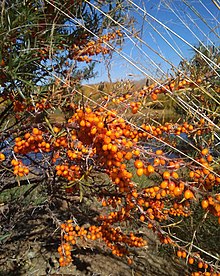ഹിപ്പൊഫീ
| ഹിപ്പൊഫീ | |
|---|---|

| |
| Common sea buckthorn shrub in the Netherlands | |
| ശാസ്ത്രീയ വർഗ്ഗീകരണം | |
| കിങ്ഡം: | |
| (unranked): | |
| (unranked): | |
| (unranked): | |
| Order: | |
| Family: | Elaeagnaceae
|
| Species | |
|
See text | |

| |
കടൽബക്ക്തോൺ സസ്യങ്ങളുടെ ഒരു ജീനസാണ് ഹിപ്പൊഫീ. ഇലാഗ്നേസീ സസ്യകുടുംബത്തിലെ ഇലപൊഴിയും കുറ്റിച്ചെടികൾ ആണിത്.[1] കടൽബക്ക്തോൺ എന്ന പേര് ബക്ക്തോൺ (റാംനസ്, കുടുംബം റാംനസീ) എന്ന സസ്യവുമായി ആശയക്കുഴപ്പം ഉണ്ടാകാറുണ്ട്. ഇതിനെ sandthorn, sallowthorn, അല്ലെങ്കിൽ സീബെറി [2] എന്നിങ്ങനെയും പരാമർശിക്കാറുണ്ട്[3]
ടാക്സോണമി
പുരാതന കാലത്ത് കടൽബക്ക്തോൺ ഇലകളും പുതിയ ശാഖകളും കുതിരകൾക്ക് ശരീരഭാരം, രോമങ്ങളുടെ കാഴ്ചഭംഗി എന്നിവ വർദ്ധിപ്പിക്കുന്നതിന് വേണ്ടി ഒരു പരിഹാരമായി കരുതപ്പെട്ടിരുന്നു. അങ്ങനെ ജീനസിൻറെ പേരിന് കാരണമായി തീർന്നു. ഹിപ്പോ (കുതിര), ഫായോസ് (തിളങ്ങുന്ന) എന്നർത്ഥത്തിൽ ഹിപ്പൊഫീ എന്ന പേരുത്ഭവിച്ചു.[4]
വിതരണം

സാധാരണ കടൽബക്ക്തോൺ (Hippophae rhamnoides) ഈ ജീനസിൽ ഏറ്റവും കൂടുതൽ വ്യാപിച്ചിട്ടുള്ള സ്പീഷീസാണ്. യൂറോപ്പിലെ അറ്റ്ലാന്റിക് തീരങ്ങൾ മുതൽ മംഗോളിയ വരെയും വടക്കുപടിഞ്ഞാറൻ ചൈനയിലേക്കും ഇതിൻറെ എട്ട് ഉപജാതികൾ വ്യാപിച്ചിട്ടുണ്ട്.[5][6]പടിഞ്ഞാറൻ യൂറോപ്പിൽ, കടൽ തീരങ്ങളിൽ മാത്രം ഒതുങ്ങി നിൽക്കുന്ന ഈ സസ്യം കടലിലെ ഉപ്പു സ്പ്രേയുടെ സാന്നിധ്യത്തിൽ മറ്റ് വലിയ സസ്യങ്ങളുടെ കടന്നുകയറ്റം തടയുന്നു. എന്നാൽ മധ്യേഷ്യയിൽ, മറ്റ് സസ്യങ്ങൾക്ക് വരണ്ട കാലാവസ്ഥയിൽ നിലനിൽക്കാൻ കഴിയാത്ത വരണ്ട അർദ്ധ മരുഭൂമി പ്രദേശങ്ങളിൽ ഇത് കൂടുതൽ വ്യാപകമാണ്.
മധ്യ യൂറോപ്പിലും ഏഷ്യയിലും, പർവ്വതത്തിനു മുകളിലുള്ള വൃക്ഷക്കൂട്ടങ്ങൾക്കിടയിൽ ഒരു ഉപ-ആൽപൈൻ കുറ്റിച്ചെടിയായി കാണപ്പെടുന്നു. നദീതടങ്ങളിലെ മറ്റ് തെളിഞ്ഞ പ്രദേശങ്ങളിൽ ഇത് മണ്ണൊലിപ്പ് തടയാൻ ഉപയോഗിക്കുന്നു.[7] വായുവിലും മണ്ണിലും കാണപ്പെടുന്ന ഉപ്പുരസത്തെ പ്രതിരോധിക്കാനുള്ള ശേഷിയും ഇവയ്ക്ക് കാണപ്പെടുന്നു, നല്ല വളർച്ചയ്ക്കായി പൂർണ്ണ സൂര്യപ്രകാശം ആവശ്യമുള്ളതും എന്നാൽ വലിയ മരങ്ങൾക്ക് സമീപം തണലിൽ ഇവ വളരുന്നില്ല. വരണ്ടതും മണൽ നിറഞ്ഞതുമായ പ്രദേശങ്ങളിൽ ഇവ നന്നായി വളരുന്നു.
ഇതും കാണുക
- Sea buckthorn oil
- Wolfberry, a native Asian plant occasionally mistaken for sea buckthorn
അവലംബം
- ↑ "Sea buckthorn". The Wildlife Trusts. Archived from the original on 2013-07-23. Retrieved 23 July 2013.
- ↑ "PLANTS Profile for Hippophae rhamnoides (seaberry)". United States Department of Agriculture. Retrieved 2007-10-08.
- ↑ 19177 ഹിപ്പൊഫീ in the Germplasm Resources Information Network (GRIN), US Department of Agriculture Agricultural Research Service. Accessed on 12 December 2017.
- ↑ Singh, Virendra (2005). "Seabuckthorn (Hippophae L.) in traditional medicines". Seabuckthorn (Hippophae L.): A Multipurpose Wonder Plant, Vol. II. New Delhi, India: Daya Publishing House. pp. 505–521. ISBN 978-81-7035-415-4.
- ↑ Li TSC (2002). Janick J, Whipkey A, eds. Product development of sea buckthorn (PDF). Trends in new crops and new uses. ASHS Press, Alexandria, VA. pp. 393–8. Retrieved 16 May 2014.
- ↑ Bartish, Igor V.; Jeppsson, Niklas; Nybom, Hilde; Swenson, Ulf (2002). "Phylogeny of Hippophae (Elaeagnaceae) inferred from parsimony analysis of chloroplast DNA and morphology". Systematic Botany. 2 (1): 41–54. doi:10.1043/0363-6445-27.1.41 (inactive 2018-09-11). JSTOR 3093894.
{cite journal}: CS1 maint: DOI inactive as of സെപ്റ്റംബർ 2018 (link) - ↑ Li TSC (2002). Janick J, Whipkey A, eds. Product development of sea buckthorn (PDF). Trends in new crops and new uses. ASHS Press, Alexandria, VA. pp. 393–8. Retrieved 16 May 2014.
കൂടുതൽ വായനയ്ക്ക്
- Beveridge, Thomas H. J.; Li, Thomas S. C. (2003). Sea buckthorn (Hippophae rhamnoides L.) production and utilization. Ottawa: NRC Research Press. ISBN 978-0-660-19007-5. Archived from the original on 2007-12-25.
- Li TSC, Oliver A. Sea buckthorn factsheet, British Columbia Ministry of Agriculture, Food and Fisheries, May 2001
- Todd, J. Introduction to sea-buckthorn, Ontario Ministry of Food, Agriculture and Rural Affairs, February, 2006